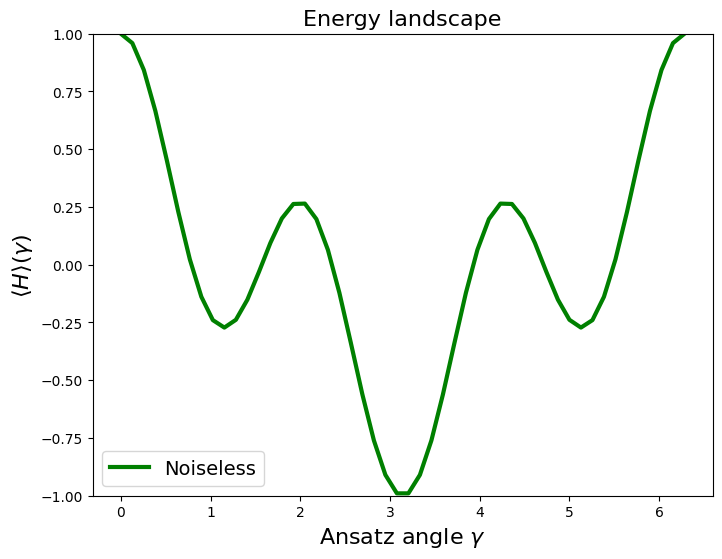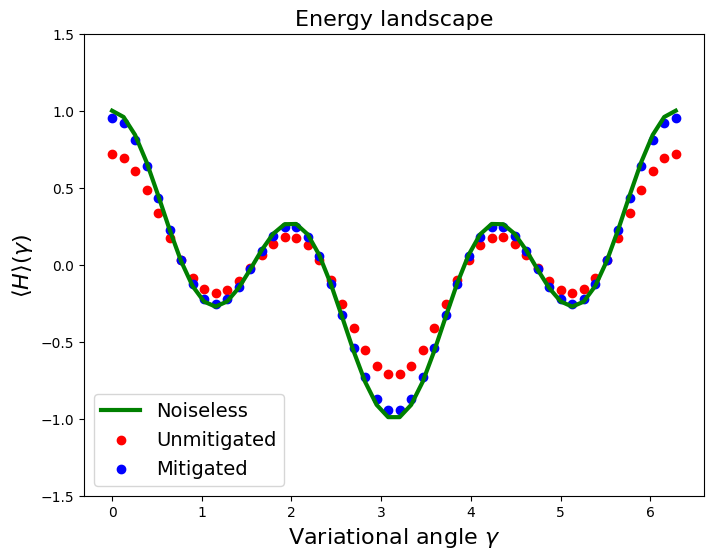Using ZNE to compute the energy landscape of a variational circuit with Braket#
This tutorial shows an example in which the energy landscape for a two-qubit variational circuit is explored with and without error mitigation, using Amazon’s Braket as our frontend.
import matplotlib.pyplot as plt
import numpy as np
from braket.devices import LocalSimulator
from braket.circuits import Circuit, Noise, Observable
from mitiq import zne
from mitiq.zne.inference import RichardsonFactory
Defining the ideal variational circuit in Qiskit#
We define a function which returns a simple two-qubit variational circuit depending on a single parameter \(\gamma\) (“gamma”).
def variational_circuit(gamma: float) -> Circuit:
"""Returns a two-qubit circuit for a given variational parameter.
Args:
gamma: The variational parameter.
Returns:
The two-qubit circuit with a fixed gamma.
"""
my_circuit = Circuit()
my_circuit.rx(0, gamma)
my_circuit.cnot(0, 1)
my_circuit.rx(1, gamma)
my_circuit.cnot(0, 1)
my_circuit.rx(0, gamma)
return my_circuit
We can visualize the circuit for a particular \(\gamma\) as follows.
circuit = variational_circuit(gamma=np.pi)
print(circuit)
T : | 0 |1| 2 |3| 4 |
q0 : -Rx(3.14)-C----------C-Rx(3.14)-
| |
q1 : ----------X-Rx(3.14)-X----------
T : | 0 |1| 2 |3| 4 |
Defining the executor functions with and without noise#
To use error mitigation methods in Mitiq, we define an executor function which computes the expectation value of a simple Hamiltonian \(H=Z \otimes Z\), i.e., Pauli-\(Z\) on each qubit. To compare to the noiseless result, we define both a noiseless and a noisy executor below. More information about executors can be found here.
# Observable to measure
Z = np.diag([1, -1])
hamiltonian = np.kron(Z, Z)
def noiseless_executor(circ: Circuit) -> float:
"""Simulates the execution of a circuit without noise.
Args:
circ: The input circuit.
Returns:
The expectation value of the ZZ observable.
"""
device = LocalSimulator('braket_dm')
# Evaluate the ZZ expectation value
circ.expectation(observable=Observable.Z() @ Observable.Z(), target=range(2))
task = device.run(circ)
result = task.result()
return result.values
# Strength of noise channel
noise_level = 0.04
def executor_with_noise(circ: Circuit) -> float:
"""Simulates the execution of a circuit with depolarizing noise.
Args:
circ: The input circuit.
Returns:
The expectation value of the ZZ observable.
"""
# Add depolarizing noise to the circuit
noise = Noise.Depolarizing(probability=noise_level)
circ.apply_gate_noise(noise)
# Use the noiseless_executor function to return the expectation value of the ZZ observable for the noisy circuit
return noiseless_executor(circ)
Note
The above code block uses depolarizing noise, but any Braket Noise channel can be substituted in.
Computing the landscape without noise#
We now compute the energy landscape \(\langle H \rangle(\gamma) =\langle Z \otimes Z \rangle(\gamma)\) on the noiseless simulator.
Note
The remaining code in this tutorial is generic and does not depend on a particular frontend.
gammas = np.linspace(0, 2 * np.pi, 50)
noiseless_expectations = [noiseless_executor(variational_circuit(g)) for g in gammas]
/home/docs/checkouts/readthedocs.org/user_builds/mitiq/envs/stable/lib/python3.11/site-packages/braket/default_simulator/simulator.py:328: UserWarning: You are running a noise-free circuit on the density matrix simulator. Consider running this circuit on the state vector simulator: LocalSimulator("default") for a better user experience.
warnings.warn(
The following code plots the values for visualization.
plt.figure(figsize=(8, 6))
plt.plot(gammas, noiseless_expectations, color="g", linewidth=3, label="Noiseless")
plt.title("Energy landscape", fontsize=16)
plt.xlabel(r"Ansatz angle $\gamma$", fontsize=16)
plt.ylabel(r"$\langle H \rangle(\gamma)$", fontsize=16)
plt.legend(fontsize=14)
plt.ylim(-1, 1);
plt.show()

Computing the unmitigated landscape#
We now compute the unmitigated energy landscape \(\langle H \rangle(\gamma) =\langle Z \otimes Z \rangle(\gamma)\) in the following code block.
expectations = [executor_with_noise(variational_circuit(g)) for g in gammas]
The following code plots these values for visualization along with the noiseless landscape.
plt.figure(figsize=(8, 6))
plt.plot(gammas, noiseless_expectations, color="g", linewidth=3, label="Noiseless")
plt.scatter(gammas, expectations, color="r", label="Unmitigated")
plt.title(rf"Energy landscape", fontsize=16)
plt.xlabel(r"Ansatz angle $\gamma$", fontsize=16)
plt.ylabel(r"$\langle H \rangle(\gamma)$", fontsize=16)
plt.legend(fontsize=14)
plt.ylim(-1, 1);
plt.show()

Computing the mitigated landscape#
We now repeat the same task but use Mitiq to mitigate errors.
We initialize a RichardsonFactory with scale factors [1, 3, 5] and we get a mitigated executor as follows.
fac = RichardsonFactory(scale_factors=[1, 3, 5])
mitigated_executor = zne.mitigate_executor(executor_with_noise, factory=fac)
We then run the same code above to compute the energy landscape, but this time use the mitigated_executor instead of just the executor.
mitigated_expectations = [mitigated_executor(variational_circuit(g)) for g in gammas]
Let us visualize the mitigated landscape alongside the unmitigated and noiseless landscapes.
plt.figure(figsize=(8, 6))
plt.plot(gammas, noiseless_expectations, color="g", linewidth=3, label="Noiseless")
plt.scatter(gammas, expectations, color="r", label="Unmitigated")
plt.scatter(gammas, mitigated_expectations, color="b", label="Mitigated")
plt.title(rf"Energy landscape", fontsize=16)
plt.xlabel(r"Variational angle $\gamma$", fontsize=16)
plt.ylabel(r"$\langle H \rangle(\gamma)$", fontsize=16)
plt.legend(fontsize=14)
plt.ylim(-1.5, 1.5);
plt.show()

Noise usually tends to flatten expectation values towards a constant. Therefore error mitigation can be used to increase the visibility the landscape and this fact can simplify the energy minimization which is required in most variational algorithms such as VQE or QAOA.
We also observe that the minimum of mitigated energy approximates well the theoretical ground state which is equal to \(-1\). Indeed:
print(f"Minimum of the noisy landscape: {round(min([exp[0] for exp in expectations]), 3)}")
print(f"Minimum of the mitigated landscape: {round(min(mitigated_expectations), 3)}")
print(f"Theoretical ground state energy: {min(np.linalg.eigvals(hamiltonian))}")
Minimum of the noisy landscape: -0.713
Minimum of the mitigated landscape: -0.946
Theoretical ground state energy: -1.0
